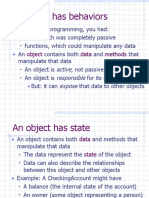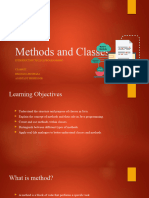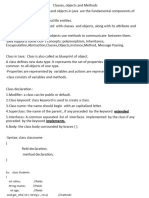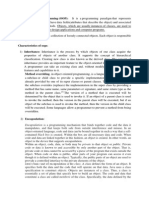0 ratings0% found this document useful (0 votes)
30 viewsLesson 4 Working With The Java Class Library
Uploaded by
Jillian LoboCopyright
© © All Rights Reserved
We take content rights seriously. If you suspect this is your content, claim it here.
Available Formats
Download as PPT, PDF, TXT or read online on Scribd
0 ratings0% found this document useful (0 votes)
30 viewsLesson 4 Working With The Java Class Library
Uploaded by
Jillian LoboCopyright
© © All Rights Reserved
We take content rights seriously. If you suspect this is your content, claim it here.
Available Formats
Download as PPT, PDF, TXT or read online on Scribd
You are on page 1/ 24
Working with the
Java Class Library
Objectives
Explain object-oriented programming and some
of its concepts
Differentiate between classes and objects
Differentiate between instance
variables/methods and class(static)
variables/methods
Explain what methods are and how to call and
pass parameters to methods
Introduction to OOP
Object-Oriented programming or OOP
Revolves around the concept of objects as
the basic elements of your programs.
These objects are characterized by their
properties and behaviors.
Introduction to OOP
Examples of objects
objects in the physical world can easily be modeled
as software objects using the properties as data
and the behaviors as methods
Encapsulation
The scheme of hiding implementation
details of a class.
The caller of the class does not need to
know the implementation details of a
class
The implementation can change without
affecting the caller of the class
Classes and Objects
Class
can be thought of as a template, a prototype or a
blueprint of an object
is the fundamental structure in object-oriented
programming
Two types of class members
Fields (properties, variables)
specify the data types defined by the class
Methods (behavior)
specify the operations
Classes and Objects
Object
An object is an instance of a class - we will
call it object instance
The property values of an object instance is
different from the ones of other object
instances of a same class
Object instances of a same class share the
same behavior (methods)
Classes and Objects
The difference between classes and objects.
Classes and Objects
Classes provide the benefit of reusability.
Software programmers can use a class
over and over again to create many object
instances.
Instance Variables (Properties)
vs. Class Variables
Instance Variables
Belongs to an object instance
Value of variable of an object instance is different
from the ones of other object object instances
Class Variables (also called static member
variables)
variables that belong to the whole class
This means that they have the same value for all the
object instances in the same class.
Class Variables
For example:
Creation of Object Instance
To create an object instance of a class, we use
the new operator.
For example, if you want to create an instance of
the class String, we write the following code,
String str2 = new String(“Hello world!”);
or also equivalent to,
String str2 = "Hello";
String class is a special (and only) class you can
create an instance without using new keyword
as shown above
Creation of Object Instance
The new operator
allocates a memory for that object and returns a
reference of that memory location to you.
When you create an object, you actually invoke the
class' constructor.
The constructor
is a method where you place all the initializations, it
has the same name as the class.
Methods
Method
is a separate piece of code that can be called by a
main program or any other method to perform some
specific function.
The following are characteristics of methods:
It can return one or no values
It may accept as many parameters it needs or no
parameter at all. Parameters are also called
arguments.
After the method has finished execution, it goes
back to the method that called it.
Why Use Methods?
Methods contain behavior of a class (business
logic)
The heart of effective problem solving is in problem
decomposition.
We can do this in Java by creating methods to solve
a specific part of the problem.
Taking a problem and breaking it into small,
manageable pieces is critical to writing large
programs.
Calling Instance Methods
To illustrate how to call methods, let's use the
String class as an example.
You can use the Java API documentation to see
all the available methods in the String class.
Later on, we will create our own methods, but for
now, let us use what is available.
To call an instance method, we write the
following,
nameOfObject.nameOfMethod(parameters);
Calling Methods
Example
String str1 = "Hello";
char x = str1.charAt(0); //will return the
character H
//and store it to variable x
String str2 = "hello";
//this will return a boolean value true
boolean result = str1.equalsIgnoreCase( str2 );
Parameter Passing
Pass-by-Value
when a pass-by-value occurs, the method
makes a copy of the value of the variable
passed to the method.
The method cannot accidentally modify the
original argument even if it modifies the
parameters during calculations.
all primitive data types when passed to a
method are pass-byvalue.
Pass-by-Value
Example
Parameter Passing
Pass-by-Reference
When a pass-by-reference occurs, the reference to
an object is passed to the calling method. This
means that, the method makes a copy of the
reference of the variable passed to the method.
However, unlike in pass-by-value, the method can
modify the actual object that the reference is
pointing to, since, although different references are
used in the methods, the location of the data they
are pointing to is the same.
Pass-by-Reference
Example
Pass-by-Reference
Calling Static Methods
Static methods
methods that can be invoked without instantiating a
class (means without invoking the new keyword).
Static methods belong to the class as a whole and
not to a certain instance (or object) of a class.
Static methods are distinguished from instance
methods in a class definition by the keyword static.
To call a static method, just type,
Classname.staticMethodName(params);
Calling Static Methods
Examples of static methods, we've used
so far in our examples are,
//prints data to screen
System.out.println(“Hello world”);
//converts the String 10, to an integer
int i = Integer.parseInt(“10”);
You might also like
- CATIA V5 Macro Programming With Visual Basic Script14% (14)CATIA V5 Macro Programming With Visual Basic Script13 pages
- Java Programming: Classes and Objects Topics Covered in This UnitNo ratings yetJava Programming: Classes and Objects Topics Covered in This Unit29 pages
- Object Classes Methods and ConstructorsNo ratings yetObject Classes Methods and Constructors55 pages
- Chapter3(part1)_fdca8665cae7a7784c6878646c6316abNo ratings yetChapter3(part1)_fdca8665cae7a7784c6878646c6316ab27 pages
- Chapter3(full)_12ee85070890f259345f6cbc37b587e6No ratings yetChapter3(full)_12ee85070890f259345f6cbc37b587e662 pages
- Chapter 7 - A Closer Look On Methods and ClassesNo ratings yetChapter 7 - A Closer Look On Methods and Classes26 pages
- More On Methods and Classes: CS F213: Object Oriented ProgrammingNo ratings yetMore On Methods and Classes: CS F213: Object Oriented Programming25 pages
- Object-Oriented Programming (OOP) : It Is A Programming Paradigm That RepresentsNo ratings yetObject-Oriented Programming (OOP) : It Is A Programming Paradigm That Represents10 pages
- Object-Oriented Software Development - Tutorial 4No ratings yetObject-Oriented Software Development - Tutorial 420 pages
- IGNOU PGDCA MCS 206 Object Oriented Programming using Java Previous Years solved PapersFrom EverandIGNOU PGDCA MCS 206 Object Oriented Programming using Java Previous Years solved PapersNo ratings yet
- Java: Advanced Guide to Programming Code with Java: Java Computer Programming, #4From EverandJava: Advanced Guide to Programming Code with Java: Java Computer Programming, #4No ratings yet
- Learning Spark Programming Basics: Introduction To RddsNo ratings yetLearning Spark Programming Basics: Introduction To Rdds70 pages
- Program Multtable Var X, Y: Byte Begin Writeln ('Enter Two Numbers From 1-9') Readln (X) Readln (Y) Writeln (X Y) EndNo ratings yetProgram Multtable Var X, Y: Byte Begin Writeln ('Enter Two Numbers From 1-9') Readln (X) Readln (Y) Writeln (X Y) End1 page
- Heapsort: Heapsort (Worst Case Complexity T (N) O (N Log N) )No ratings yetHeapsort: Heapsort (Worst Case Complexity T (N) O (N Log N) )46 pages
- Information Technology Practical File: For Secondary School Certificate ExaminationNo ratings yetInformation Technology Practical File: For Secondary School Certificate Examination16 pages
- Computer Science Grade X IG Pre-Board-2 Examinatin 2020-21No ratings yetComputer Science Grade X IG Pre-Board-2 Examinatin 2020-2110 pages
- Chapter Four: System Design: Werabe University Institute of Technology Department of Information SystemsNo ratings yetChapter Four: System Design: Werabe University Institute of Technology Department of Information Systems23 pages
- RSLTE031 - Neighbor HO Analysis-RSLTE-ECI-2-Day-rslte LTE17A Reports RSLTE031 DanubyuNo ratings yetRSLTE031 - Neighbor HO Analysis-RSLTE-ECI-2-Day-rslte LTE17A Reports RSLTE031 Danubyu24 pages
- Automatic Hyperparameter Tuning With Sklearn Using Grid and Random Search - by Bex T. - Towards Data ScienceNo ratings yetAutomatic Hyperparameter Tuning With Sklearn Using Grid and Random Search - by Bex T. - Towards Data Science8 pages

























































































